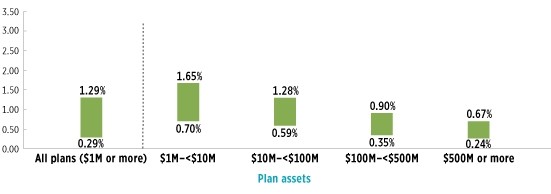News Release
Retirement Plan Fees Vary with Plan Size and Diversified Equity Holdings, Deloitte/ICI Study Finds
Washington, DC, August 20, 2014—A comprehensive study of the factors that appear to drive fees in 401(k) and other defined contribution (DC) retirement plans, released today by Deloitte and the Investment Company Institute, indicated that plan size, average participant account balance, and percentage of plan assets invested in diversified equity holdings are drivers of fees.
The study, Inside the Structure of Defined Contribution/401(k) Plan Fees, 2013, updates the 2011 survey and looks at total fees charged across a broad sample of 357 employers, representing 361 DC plans with $1 million or more in plan assets. These plans had a range of plan sizes, service levels, investment offerings, retirement service providers, and fee structures. Using an exclusive survey that gathered data from each of the plans studied, Deloitte researchers calculated an “all-in” fee for each plan that captured administrative, recordkeeping, and investment-related fees—whether paid by the plan sponsor, the participant, or the plan—as a percentage of plan assets.
A key finding of the study is that, for the companies surveyed, the number of participants and the average participant account balance in the plan are drivers of a plan’s all-in fee. Specifically, plans with more participants and higher average account balances typically had lower all-in fees, benefitting from economies of scale by spreading fixed administrative costs over more assets and participants.
The percentage of a plan’s assets invested in diversified equity holdings was also found to be a driver of the all-in fee. Plans with higher allocations to diversified equity holdings tended to have higher all-in fees as a percentage of plan assets, consistent with the fact that equity investment options generally have higher expenses than other types of investments.
“Consistent with prior years, this study helps to differentiate the factors that drive fees from a number of other plan features that do not appear to have a significant impact on fees for the companies studied,” explained Scott Parker, a principal with Deloitte Consulting LLP who led the research effort. “It’s notable that the primary drivers of fees continue to be the size of the plan as measured by number of participants and average account balance, as opposed to other features that might be associated with complexity in servicing plans, which did not appear to have a significant effect on fees.”
Though any individual participant’s experience depends on the DC plan offered by his or her employer, the median DC plan participant is in a plan with an all-in fee of 0.67 percent of assets, based on plans included in the study. Across all participants, the all-in fee ranged from 0.29 percent of assets (the 10th percentile participant) to 1.29 percent of assets (the 90th percentile participant). The median annual “all-in” fee per participant was $267.
All-In Fee Range: 10th and 90th Percentiles of Participants by Plan Asset Size Segment (Participant-Weighted)
Percentage of assets

Note: Sample includes 401(k) plans with plan assets of $1 million or more.
Source: Deloitte/ICI Defined Contribution/401(k) Plan Fee Survey
“401(k) and other DC plans represent about one-quarter of Americans’ retirement assets and play a vital role in Americans’ retirement security,” said Sarah Holden, ICI senior director of retirement and investor research. “This study can inform policymakers, employers, plan service providers, and workers about what plans cost and what factors are the key drivers of plan fees.”
Though the survey was not intended to provide a statistical representation of the DC plan market, the survey respondents represent a wide cross section of plans. The 361 plans surveyed from June through December 2013 covered a range of asset sizes and participant counts, examining plans with assets of $1 million or more, ranging from fewer than 100 to more than 10,000 participants. Collectively, the sample covered 2.7 million participants and $240 billion in plan assets.
To better represent the universe of 401(k) plans, survey responses were weighted to Department of Labor (DOL) data based on plan assets and number of plan participants. Though 87.3 percent of all 401(k) plans have fewer than 100 participants, large shares of assets (45.5 percent) and participants (40.9 percent) are in plans with 10,000 or more participants. To focus on the fee experience of workers in 401(k) plans, all-in fee results in the report typically are calculated on a participant-weighted basis. Because the sample included plans with $1 million or more in assets, results were weighted to the comparable DOL universe of 401(k) plans with $1 million or more in assets.
